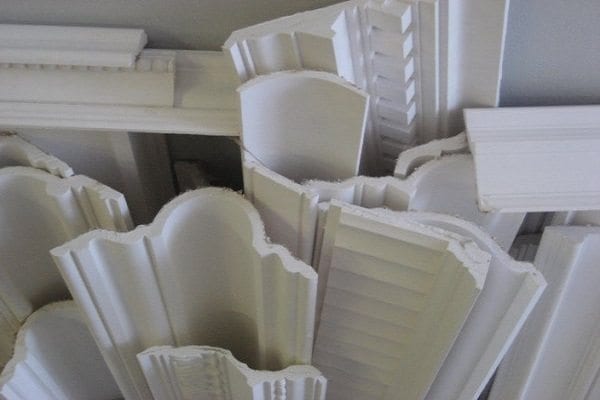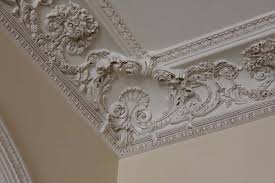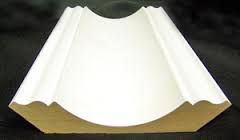
8 common crown molding materials
Wood, plaster and polyurethane are the most common crown molding materials. But they’re hardly interchangeable when it comes to price, quality and ease of installation.
Here is a rundown of common crown molding materials and their uses.
Popular crown molding materials
 Solid wood. Hardwoods like oak and mahogany are the most traditional modeling material, and Pros swear by them because homeowners love their aesthetic—and because they resist cracking. When stained, their natural grain shows through. And both hardwoods and softwoods can be carved into ornate pieces.
Solid wood. Hardwoods like oak and mahogany are the most traditional modeling material, and Pros swear by them because homeowners love their aesthetic—and because they resist cracking. When stained, their natural grain shows through. And both hardwoods and softwoods can be carved into ornate pieces.
Althoug wood is one of the most common crown molding materials, some contractors say wood can be tricky to cut and install, and if it gets wet, it can rot. And because wood shrinks and swells with changes in the weather, it’s not always the contractor’s first choice for crown molding jobs that involve corners.
Hardwood prices vary, so some Pros—and their clients—prefer less-expensive softwoods like pine, especially for crown molding that will be painted instead of stained and mounted on ceilings and high on walls, where it is unlikely to get dented.
Pricey crown molding materials
 Plaster. This hand-cast molding can be crafted with elaborate, elegant designs—and the client will pay dearly for it. Typically made to order in six-foot lengths, plaster is the most-expensive crown molding material. The rigid, heavy material cracks easily and is not a easy to install, usually requiring screws and construction adhesive rather than nails.
Plaster. This hand-cast molding can be crafted with elaborate, elegant designs—and the client will pay dearly for it. Typically made to order in six-foot lengths, plaster is the most-expensive crown molding material. The rigid, heavy material cracks easily and is not a easy to install, usually requiring screws and construction adhesive rather than nails.
Plaster crown molding must be painted, not stained, because of its slick surface and joints that are filled with plaster. But it’s a favorite among homeowners who want a grand interior beyond what wood can offer.
Plaster-covered foam. Less ornate but far easier to work with, plaster-covered foam is as flexible as wood. Trim pieces typically are manufactured in eight-foot lengths, filled with extruded polystyrene and coated with fiberglass and acrylic plaster. Plaster-covered foam is far less expensive than solid plaster molding, but still more expensive than other moldings.
Flex. Among some of the most common crown molding materials, flex is a rubbery material that can bend around bay windows and curved walls. Flex crown molding is expensive and must be special-ordered. Still, it’s cheaper to trim curved windows and arched doorways with flexible molding than to do a custom carpentry job.
Flex molding is a type of polyurethane, so it doesn’t break or split. Still, some contractors complain that when they view the trim close-up, it resembles Styrofoam, and its edges have an unpolished look.
Budget conscious
Medium-density fiberboard (MDF). Once considered a “poor man’s” wood for molding because of its low cost, MDF started attracting interest from contractors during the 2007-2009 recession, when homeowners were pinching pennies on remodeling projects.
MDF, engineered from wood fibers glued under heat and pressure, is ultra-lightweight and easy to cut with miter saw blades, and to install and paint.
 But it doesn’t hold up in damp rooms like laundry rooms, basements, bathrooms or kitchens; MDF swells and buckles when it gets wet, and it typically doesn’t last as long as wood. Plus, it dents easily, especially on its corners, so it’s not the best choice for baseboards or chair rails in homes with small children.
But it doesn’t hold up in damp rooms like laundry rooms, basements, bathrooms or kitchens; MDF swells and buckles when it gets wet, and it typically doesn’t last as long as wood. Plus, it dents easily, especially on its corners, so it’s not the best choice for baseboards or chair rails in homes with small children.
However, when it’s installed at the intersection of a wall with a ceiling—where it won’t be bumped into and damaged—it can last a long time and do a good job of mimicking more-expensive wood trim.
Still, the product has a black eye because of the formaldehyde in the glue that holds the fibers together. Despite efforts by manufacturers to publicize lower-formaldehyde formulas, many homeowners—and their contractors—shy away from the material.
Polyurethane. Softer than wood, polyurethane, an extruded product, does a good job of imitating wood—at least when it’s mounted near the ceiling. Yet it’s more resistant to rot and insects than wood, and it costs less.
Installers report that the material cuts like pine and paints just as well. And manufacturers are designing polyurethane molding with elaborate designs that mimic carved wood. But its installation requires extra care, as the material is softer than wood and dents easily. Also, staining it is not an option.
PVC. Plastic does not rot or warp when it gets wet, so PVC is the choice of contractors whose clients want to molding on the walls, ceilings and baseboards of bathrooms or the exteriors of their homes. Its designs are not as intricate as those crafted with polyurethane or wood, and and the product, which has a slick surface, must be painted, not stained.
Polystyrene. Budget-minded homeowners like polystyrene molding, which is light and less expensive to buy and install than other kinds of trim. Installers like it, too, because no power tools are needed to cut this lightweight foam material; scissors or a knife saw right through it. It requires no nailing during installation, either; construction adhesive holds it in place.
– Sharon O’Malley

